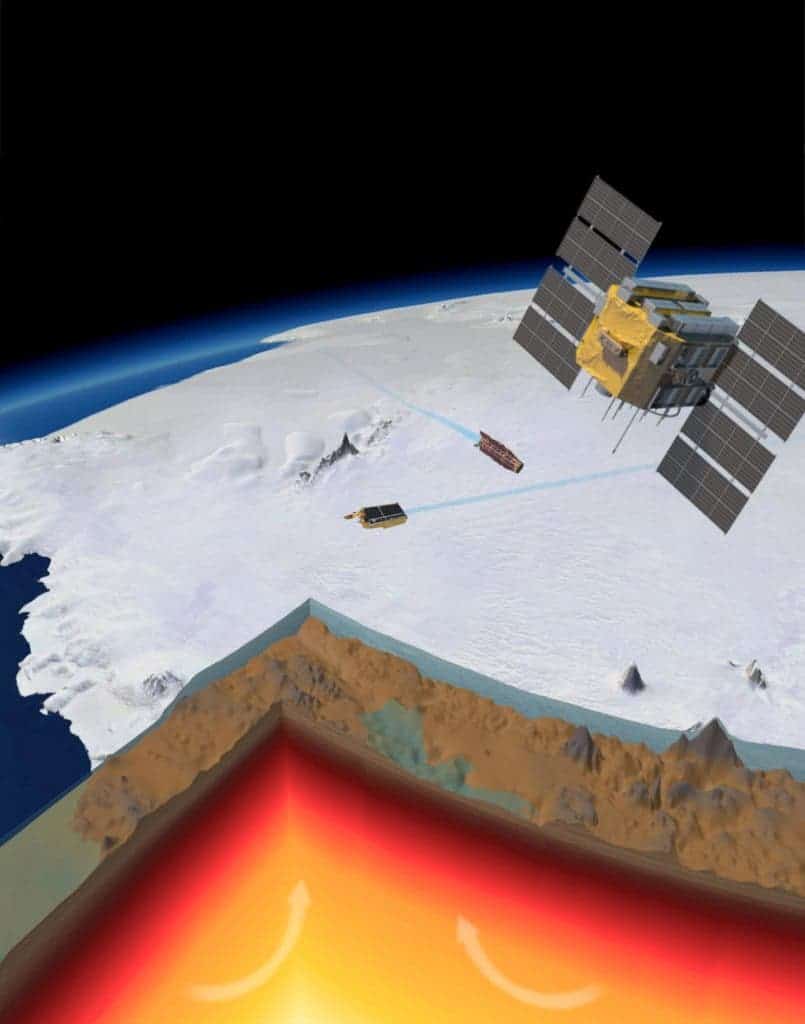
The bedrock underneath West Antarctica is rising at an astonishing rate, slowing down ice melt in a region where scientists have identified some of the most vulnerable glaciers. This is a rare bit of good news but scientists caution that this spring action shouldn’t substitute real action — which is the only solution to averting runway melting of the West Antarctic ice sheet.
The findings concern the bedrock of West Antarctica which hosts the Pine Island and Thwaites glaciers, two of the fastest-melting glaciers on the planet. Should these two melt completely, sea levels would rise by a couple of feet, flooding millions of homes across coastal regions around the world and possibly crossing some island states off the map.
Pine Island and Thwaites can be found some 4000km away from the southernmost tip of South America, where they sit on a 300km long frozen plain and stem from a 3km-thick ice pool roughly the size of Texas.
“Together, they act as a plug holding back enough ice to pour 11 feet (3.4m) of sea-level rise into the world’s oceans,” US meteorologist Eric Holthaus, who was not involved in the present study, said in 2017.
Scientists have always been worried about the rapid collapse of the two monstrous glaciers. As warm water seeps through the cracks, it creates rifts in the glacier that eventually cause floating shelves — which drift away and melt. The bedrock gets deeper the further inland you go, causing progressively-thicker shelves to break off as every new iceberg exposes taller and taller cliffs. Because the ice so heavy the further inland meltwater gets, these taller cliffs can no longer support their own weight, setting off a crumbling chain reaction.

In a previous study, scientists estimated these key glaciers could conceivably collapse within 20 to 50 years. But new research led by Valentina Barletta, a geophysicist from the Technical University of Denmark, revealed that bedrock underneath the glaciers is rising rapidly, which will delay melting considerably.
Earth’s memory foam
Our planet’s mantle, on which the crust lies, is known to move up and down slightly thanks to a process of convection, wherein heat from the earth’s interior travels up and slowly lifts it, creating a wave that travels around the earth. The mantle also sinks or lifts as mass is deposited or removed from atop of it. Because of this, the mantle is lower in some places (where a huge glacier might sit, for instance) and higher in other places. Image sitting on a waterbed — you sink in it but, at the same time, water sloshes onto the side. When the mantle rises because of a melting glacier, scientists call this a glacier rebound.
The research team placed six GPS sensors across the Amundsen Sea Embayment, following them as they shifted up or down in time. They also used satellite measurements to monitor how the surface levels of nearby glaciers were dropping, as the ice melted.
The researchers found that the bedrock beneath the ice is rising unexpectedly quickly, at an astonishing rate of 41 millimeters (about 2 inches) per year, as reported in the journal Science. This means that the bedrock in West Antarctica could gain 8 to 10 meters by the end of this century, when the uplift rates at the GPS sites will be 2.5 to 3.5 times more rapid than currently observed. Remember the waterbed analogy; according to Barletta, a combination of gravitational effects raises the sea level in northern Europe, as Antarctica loses ice. In contrast, when Greenland loses ice, it raises the sea level in the southern hemisphere.
“The results of our work will provide a very important contribution in the understanding of dynamics of the Earth along with the ice melting processes in Antarctica,” said Barletta in a statement.
“The rapid rise of the bedrock in this part of Antarctica suggests that the geology underneath the ice is different from what scientists had previously believed. The rate of uplift we found is unusual and very surprising. It’s a game changer,” said Terry Wilson, one of the leaders of the study and professor emeritus of Earth Sciences at Ohio State University.
Researchers say that we shouldn’t be overly optimistic about this good news. The planet’s atmosphere is still warming rapidly and CO2 levels are increasing, and with sufficient rapid warming, the two mega-glaciers are bound to retreat eventually.
“Apart from giving us a new picture of the earth dynamics in Antarctica, the new findings will push to improve ice models for WAIS to get a more precise picture of what will happen in the future” said Barletta. “They also tell that we clearly need to improve our knowledge of the Earth structure under the whole Antarctic continent.”






